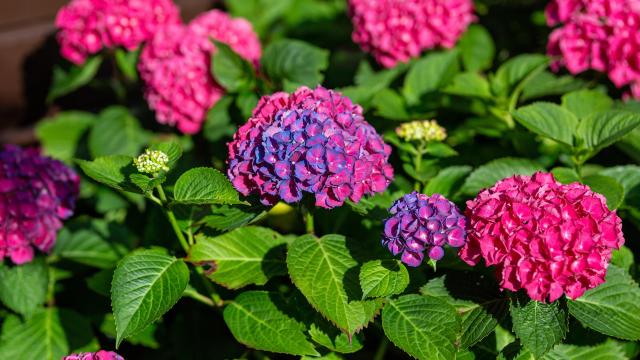Love your hydrangeas, but want to see how they would look in a different colour? Depending on the variety, you may be able to change their colour yourself. Here’s what to know.
Not all hydrangeas can change colour
Before going any further, we should mention that not all hydrangeas are capable of changing colour. The ones with this ability include some Bigleaf hydrangeas (H. macrophylla) — especially Mophead and Lacecap types — and H. serrata cultivars. And while pink and blue hydrangeas of these varieties can change colour, those with white flowers cannot.
How do hydrangeas change colour?
The Farmers Almanac recommends waiting until a hydrangea plant is at least two years old before attempting to change the colour of its flowers. It’s also important to keep in mind that the change in colour doesn’t happen instantly: It typically takes several weeks or months for the transformation to occur.
The colour of hydrangeas is determined by how much aluminium the plant is able to absorb from the soil — and that depends on the soil’s pH.
Soil with a lower pH makes it easier for plants to absorb aluminium, which usually makes its flowers blue. Meanwhile, soil with a higher pH makes it harder for the plant to access aluminium, which usually means its flowers will be pink.
How to change the colour of hydrangeas
First, you’ll need to test your soil’s pH. Also, make sure to have some aluminium sulfate on hand. Here’s what to do next:
How to change pink flowers to blue flowers
To go from pink to blue flowers, increase the acidity of the soil. You can do this by applying a solution of 1⁄4-ounce aluminium sulfate per gallon of water, three times a year, starting in the spring.
Repeat the process three or four weeks later, and then again three or four weeks after that. When you use the aluminium sulfate solution in the spring, also apply 25-5-30 fertiliser, per the manufacturer’s instructions.
How to change blue flowers to pink flowers
To go from blue to pink flowers, increase the alkalinity of your soil. You can do this by spreading ground limestone (dolomitic lime) at a ratio of four pounds per 9 sq km in the spring or autumn, and making sure it gets plenty of water. At the same time, put 25-10-10 fertiliser on the plant, following the manufacturer’s instructions.
And if you happen to have water with a high mineral content (also known as hard water), that can assist in turning blue flowers pink.

Leave a Reply
You must be logged in to post a comment.